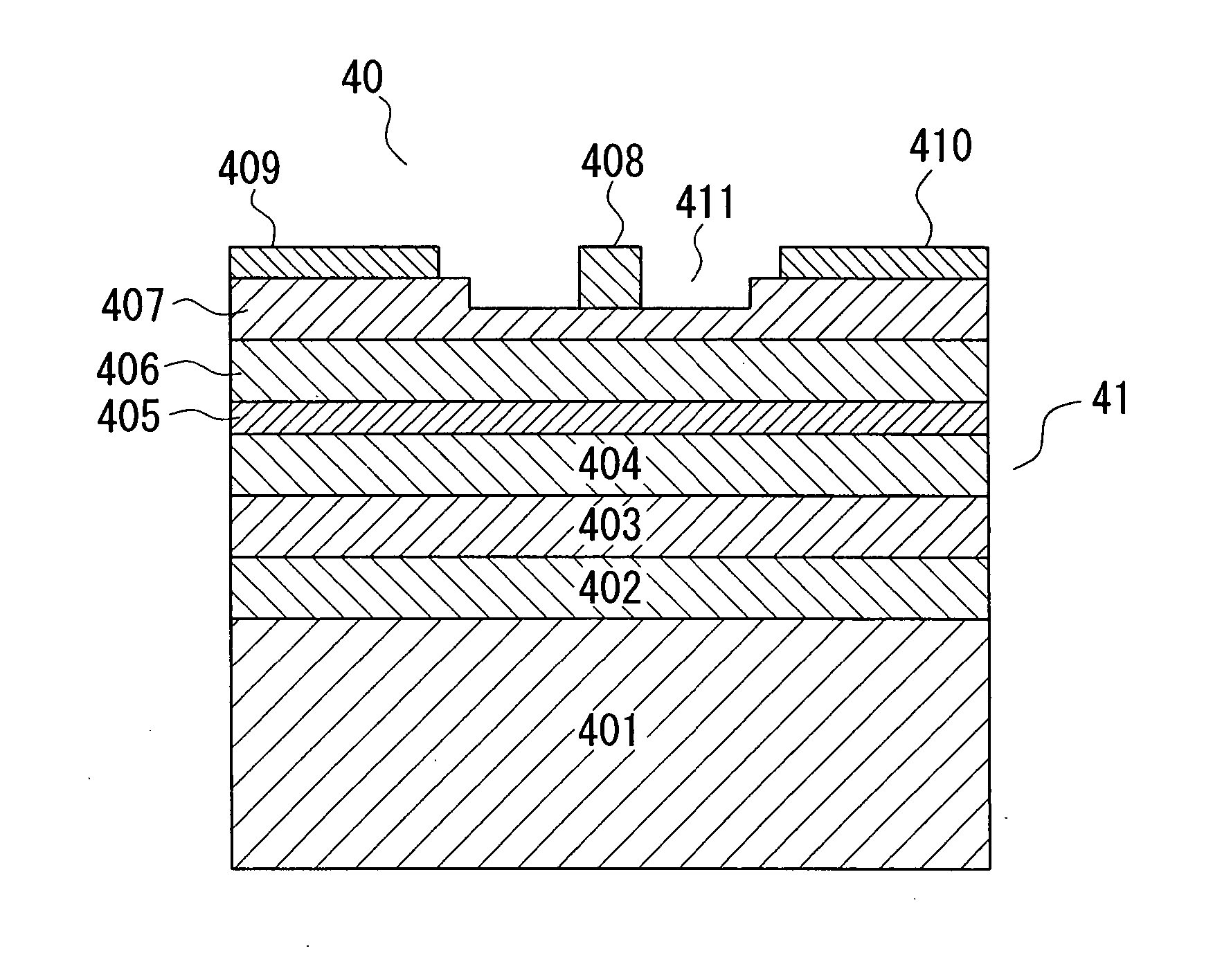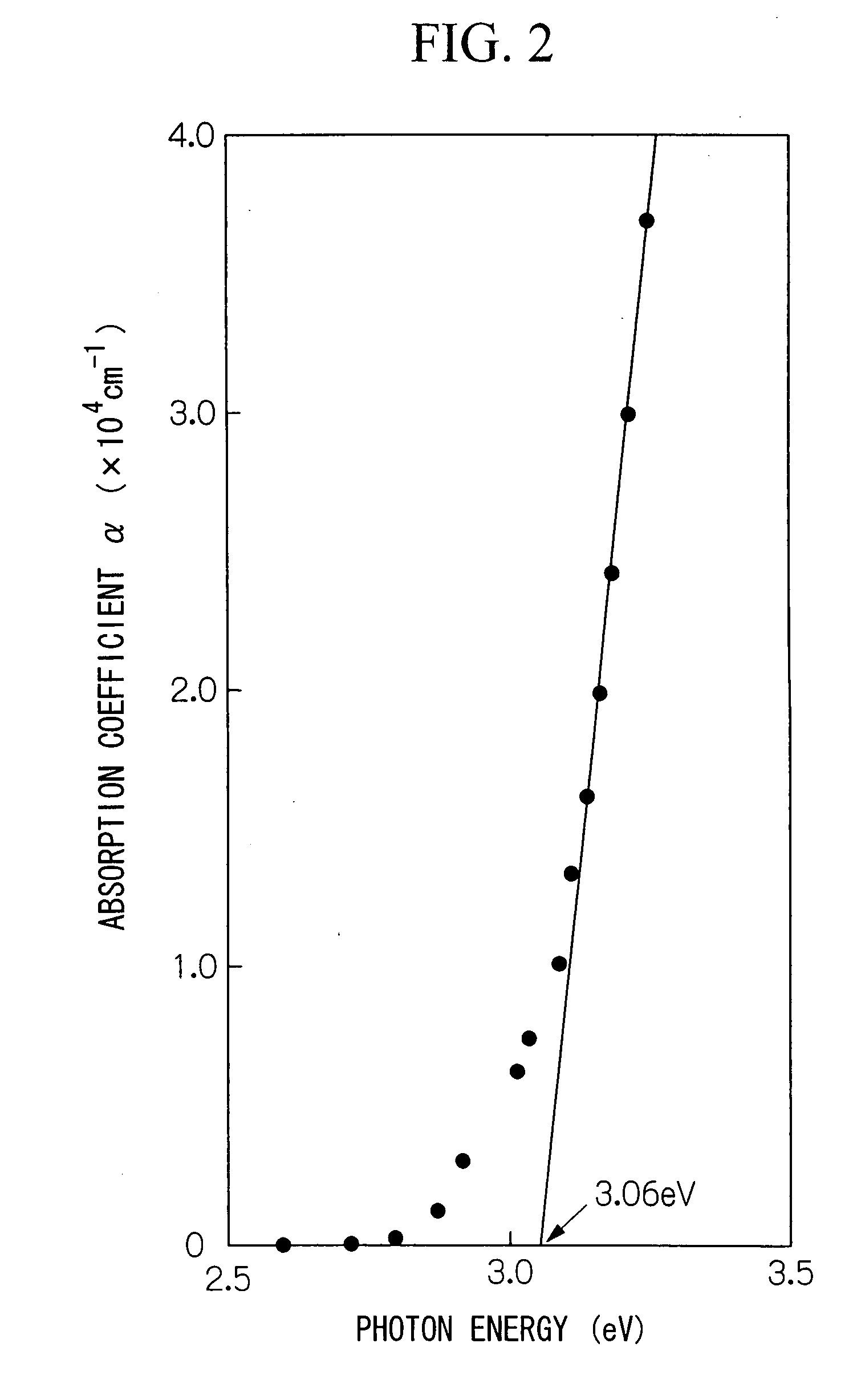Semiconductor device, semiconductor layer and production method thereof
a semiconductor and semiconductor layer technology, applied in the direction of sustainable manufacturing/processing, crystal growth process, final product manufacturing, etc., can solve the problems of difficult to obtain crystal layer having good quality, difficult to construct environmental-resistant semiconductor devices having high breakdown voltage,
- Summary
- Abstract
- Description
- Claims
- Application Information
AI Technical Summary
Benefits of technology
Problems solved by technology
Method used
Image
Examples
example 1
[0118] In Example 1, the present invention is described in detail by referring to a Group III nitride semiconductor LED using the BP semiconductor layer of the present invention. FIG. 6 schematically shows a cross sectional structure of the pn junction type LED 60 of Example 1.
[0119] The stacked layer structure 61 for use in LED 60 was constructed using a boron (B)-doped p-type Si single crystal having a (111) plane as the substrate 601. The low-temperature buffer layer 602 on the substrate 601 was composed of boron phosphide (BP) with the main part being amorphous in the as-grown state. The low-temperature buffer layer 602 was grown at 350° C. by an atmospheric pressure MOCVD method using a triethylborane ((C2H5)3B) / phosphine (PH3) / hydrogen (H2) system. The layer thickness of the low-temperature buffer layer 602 was about 12 nm.
[0120] Using the above-described MOCVD vapor phase growth method, a magnesium-doped p-type BP layer was stacked at 950° C. as a lower clad layer 603 on th...
example 2
[0127] In Example 2, the present invention is described in detail by referring to a pn junction-type diode having the boron phosphide (BP) layer specified in the present invention. FIG. 9 schematically shows a cross sectional structure of the pn junction-type diode 90 of Example 2.
[0128] On a phosphorus (P)-doped n-type Si single crystal substrate 901 having a (111) plane, a low-temperature crystal layer 902-1 composed of boron gallium phosphide (BXGa1-XP) was stacked at 400° C. by a reduced pressure MOCVD method using a diborane (B2H6) / (CH3)3Ga / H2 system. The boron (B) composition ratio (═X) was set to 0.02 so as to attain lattice-matching to the Si single crystal (lattice constant=0.5431 nm). The low-temperature crystal layer 902-1 was grown under reduced pressure of about 1.3×104 pascals (Pa). The layer thickness of the low-temperature crystal layer 902-1 was about 4 nm.
[0129] When observed by a sectional TEM method, in the B0.02Ga0.98P low-temperature crystal layer 902-1 in th...
example 3
[0136] In Example 3, the present invention is described in detail by referring to an npn junction-type hetero bipolar transistor (HBT) having the BP-base mixed crystal containing boron phosphide (BP) of the present invention. FIG. 11 is a schematic sectional view of the npn junction-type HBT 10 of Example 3.
[0137] On a phosphorus (P)-doped n-type Si single crystal substrate 101 having a (100) plane, a low-temperature buffer layer 102 composed of boron gallium phosphide (BXGa1-XP) was stacked at 350° C. by a reduced pressure MOCVD method using a diborane (B2H6) / (CH3)3Ga / H2 system. The boron (B) composition ratio (═X) was set to 0.02 so as to attain lattice-matching to the Si single crystal (lattice constant=0.5431 nm). The low-temperature buffer layer 102 was grown under a reduced pressure of about 1.3×104 pascals (Pa). The layer thickness of the low-temperature buffer layer 102 was about 14 nm.
[0138] On the B0.02Ga0.98P low-temperature buffer layer 102, respective functional layer...
PUM
| Property | Measurement | Unit |
|---|---|---|
| band gap | aaaaa | aaaaa |
| band gap | aaaaa | aaaaa |
| temperature | aaaaa | aaaaa |
Abstract
Description
Claims
Application Information
 Login to View More
Login to View More - R&D
- Intellectual Property
- Life Sciences
- Materials
- Tech Scout
- Unparalleled Data Quality
- Higher Quality Content
- 60% Fewer Hallucinations
Browse by: Latest US Patents, China's latest patents, Technical Efficacy Thesaurus, Application Domain, Technology Topic, Popular Technical Reports.
© 2025 PatSnap. All rights reserved.Legal|Privacy policy|Modern Slavery Act Transparency Statement|Sitemap|About US| Contact US: help@patsnap.com



